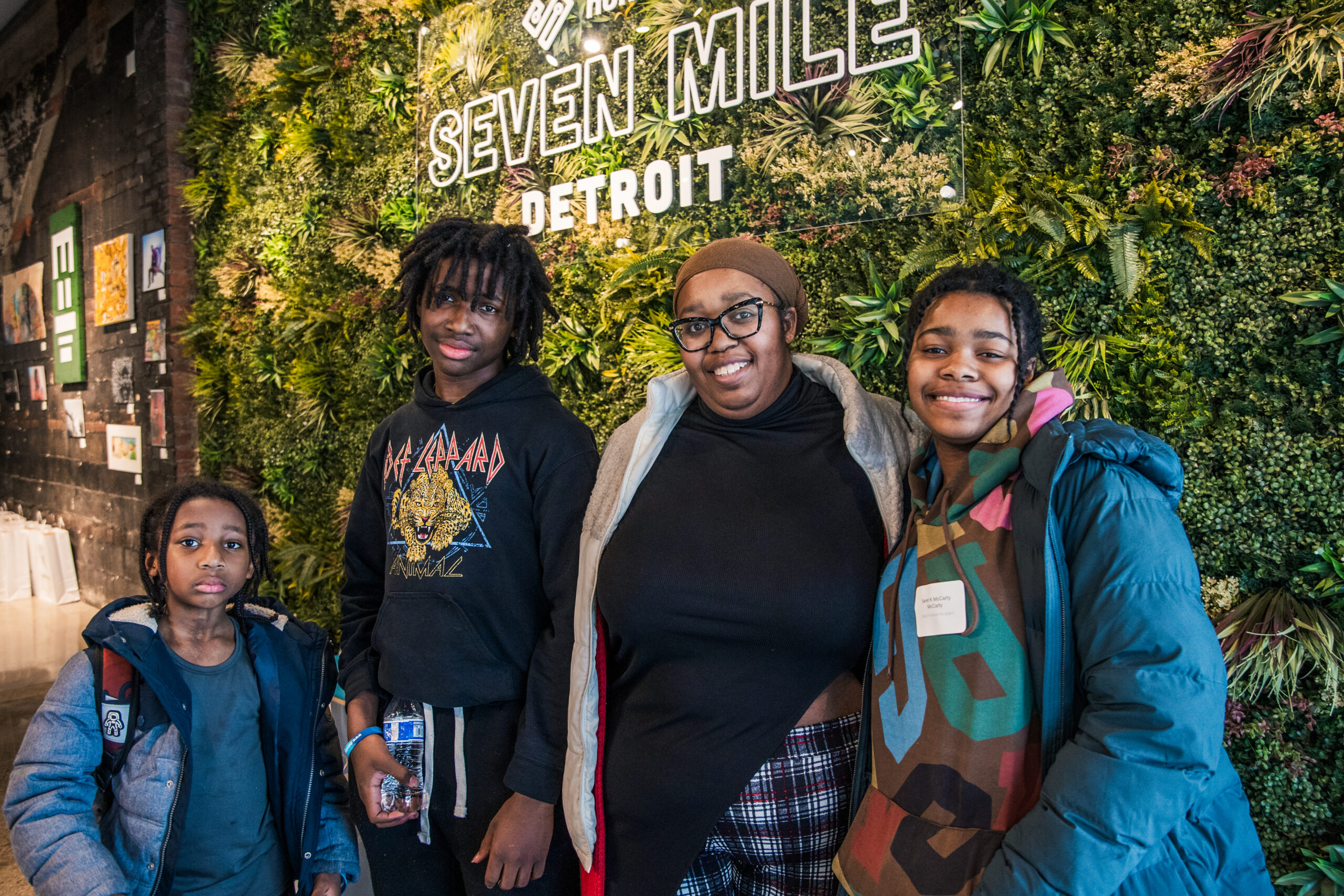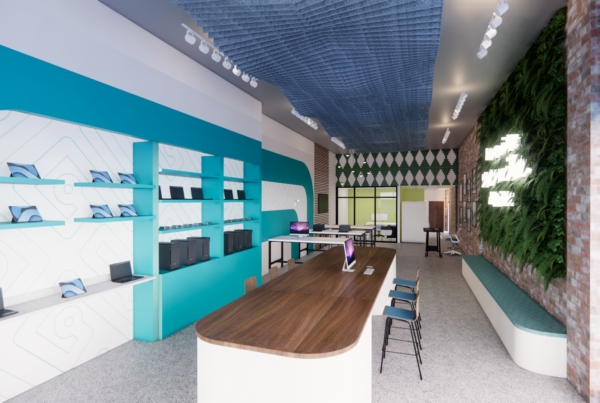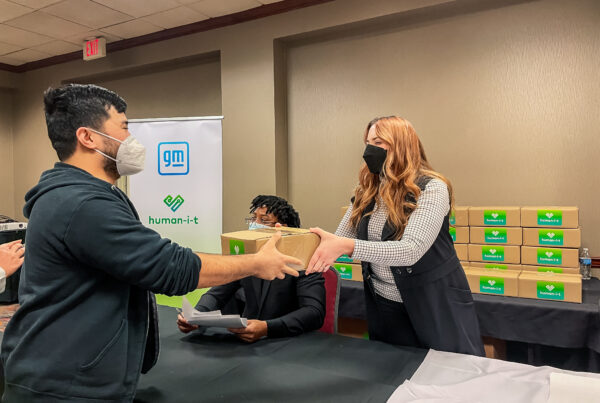New research from data scientist Hari Narayanan proves what Human-I-T knew back in 2020: Digital equity solutions need more than just cables and towers. Detroit has 98.4% broadband availability, but only 73% of people actually use the internet. That’s a huge gap and a real problem. It shows that the digital divide in Detroit isn’t necessarily about access.
Most companies focus on building faster networks. But fancy internet means nothing if families can’t afford computers. Or if they don’t know how to stay safe online.
And now, the new data from Hari Narayanan is validating what we’ve always known. It shows a 21-point gap between Detroit’s best and worst connected neighborhoods. Sadly, this gap comes from decades of unfair treatment that fiber optic lines can’t fix.
Real digital inclusion in Detroit means helping real people overcome real barriers. And those barriers go way deeper than technology.
Table of Contents
- The Data Validates What We Already Knew
- From 40% to 70%: Detroit’s Transformation Proves Community-First Approaches Work
- The Four Pillars: Addressing Root Causes, Not Symptoms
- A Sustainable Model for National Scale
The Data Validates What We Already Knew
Narayanan’s research reveals two different Detroits: one cluster with 80% internet adoption, another stuck at just 59%. What separates these communities? Not internet access. Both have the same infrastructure. The difference lies in poverty rates, income levels, and the lasting effects of redlining.
Low-income neighborhoods face barriers that go beyond monthly internet bills. Families earning between $20,000 and $25,000 have only 40% internet access compared to 78% for those making $50,000 to $75,000. Device access creates another hurdle. Only 86.4% of people with disabilities use computing devices versus 95% without disabilities.
Why Human-I-T Chose Detroit
Back in 2020, Detroit was America’s least connected major city at just 40% digital inclusion. We didn’t pick Detroit because it needed more cell towers. We chose it because we saw the real problem of systemic barriers. Barriers that kept (and still keep) good people from getting online despite having the technology right outside their doors — literally.
While other organizations focused on building more infrastructure, Human-I-T recognized that historical disinvestment, affordability challenges, and trust issues were the real culprits. These socioeconomic factors demanded a completely different approach. An approach that put community needs first and technology second.
The research confirms having access to internet doesn’t guarantee that one is connected to it.
From 40% to 70%: Detroit’s Transformation Proves Community-First Approaches Work
The Transformation That Changed Everything
Detroit’s digital story changed dramatically between 2019 and 2023. The city went from 40% digitally included to 70%. It transformed from America’s least connected major city into a digital inclusion success story. How? Partnerships.
Human-I-T is proud to have played a key role in this citywide transformation. We became part of something bigger, joining forces with organizations that understood the same truth. Real change requires working together, not working around each other.
Closing the Digital Divide in Detroit: Building an Ecosystem, Not Just Programs
The Rocket Community Fund provided crucial support, helping us open Detroit’s first warehouse in 2020. Their corporate e-waste donations —10 to 20 pallets every quarter — continue to fuel our device refurbishment programs.
Connect 313 coordinates citywide efforts that make individual programs stronger. Through this collaboration, tech hubs expanded from 5 to 22 locations across Detroit. And the City of Detroit’s Office of Digital Inclusion ensures our work aligns with broader community goals.
Our 7 Mile store represents something unprecedented: America’s first digital equity retail location. Not only is what is now called the Digital Empowerment Center symbolic. It’s literal proof that digital equity solutions like ours can scale sustainably.
Why Being “Of the Community” Matters
External programs often fail because they impose solutions from outside. Human-I-T embedded ourselves directly in Detroit’s culture and community. Our 7 Mile location sits in the heart of the community we serve. It’s accessible by public transportation and open six days a week.
Staff members live in Detroit neighborhoods. They understand local challenges because they face — or have faced — them personally. This creates trust that ZIP code data can’t capture. But families feel it the moment they walk through our doors.
The Four Pillars: Addressing Root Causes, Not Symptoms
Detroit’s incredible transformation proves that a community-first approach works. This success is built on the foundation of our four-pillar model, which is designed to tackle the root causes, not just the symptoms, of the digital divide.
Many organizations treat digital divide symptoms. Not us. Human-I-T tackles the disease itself. Our approach is designed to help remove barriers that keep families offline. And the digital divide in Detroit is a perfect example of solving these problems.
Low-Cost Devices That Actually Work
Device access remains a massive roadblock in Detroit’s lowest-adoption neighborhoods. Families obviously can’t get online without reliable computers and tablets. Traveling to locations like libraries to use computers isn’t always feasible or sustainable. And it’s certainly inconvenient. Our sustainable refurbishment model transforms corporate (and even individual) e-waste into opportunity. So we’re able to get devices to people who need them most.
Fresh laptops or desktops can cost upwards of $700+. We offer laptops that start as low as $130. Name brand devices like HP, Dell, and Apple. Our tech is made even less expensive and more accessible through payment plans and income-qualified discounts. Every device gets thoroughly tested and comes with warranties. Because high-quality technology shouldn’t be a luxury item.
Affordable Internet Access
Research shows affordability as the top barrier in Detroit’s struggling ZIP codes. Monthly internet bills can eat up huge chunks of tight budgets. It contributes heavily to the digital divide in Detroit. Our Gold Membership program slashes internet costs through partnerships with major providers.
We negotiate directly with carriers to secure discounts that individual families can’t get alone. Low-cost plans start at $15 per month for qualified households. Free installation eliminates setup barriers. Some families get internet for the first time in their lives through these partnerships.
Digital Literacy Training for Today’s World: Bridging the Digital Divide in Detroit
Having a computer means nothing without knowing how to use it safely. Skills gaps create real barriers. Adults who can’t navigate job applications online, parents unable to help kids with digital homework, or families who avoid banking websites because they don’t understand online safety.
Our free digital training through Cisco tackles these everyday challenges head-on. Classes teach practical skills like creating secure passwords, recognizing scam emails, and safely accessing government benefits online. We show parents how to set up parental controls and help job seekers master online applications that employers expect.
Training happens in neighborhoods where people live and work — not downtown locations that require long bus rides. Instructors speak the community’s languages and understand local challenges. Our newest program teaches AI skills because the next digital divide is already forming. These courses prepare people for jobs that didn’t exist five years ago, ensuring families stay ahead of technological changes instead of falling further behind.
Ongoing Tech Support That Builds Trust
And last but not least. Technology breaks. People get confused. Without reliable help, many families give up entirely. Our bilingual tech support operates 24/7 with real humans who understand community needs.
Spanish-speaking technicians serve Detroit’s Latino communities. Support doesn’t end after device pickup—it continues for as long as people need help.
These four pillars work together because Detroit’s digital challenges don’t exist in isolation. Transforming a city requires comprehensive solutions that address multiple barriers simultaneously.
A Sustainable Model for National Scale
These four pillars work together because digital challenges don’t exist in isolation. And it’s this integrated, comprehensive approach that makes our model not only effective in Detroit but also a sustainable solution that can be replicated on a national scale.
Two Problems, One Solution
The e-waste crisis and digital divide often seem like separate challenges. One’s environmental. And one is an issue of social justice. Human-I-T proves they’re actually connected solutions. Corporate technology becomes obsolete every few years, creating mountains of waste. Meanwhile, families struggle without affordable devices.
Our model transforms this problem into opportunity.
Unlike programs dependent on grants that disappear, Human-I-T operates sustainably. Corporate social responsibility partnerships provide steady e-waste streams that fund our four-pillar approach. Companies get secure data destruction and environmental compliance. Communities get digital access.
This framework scales to any city facing similar challenges. And Detroit proves the model works. Other communities can adapt it locally while maintaining core principles.
Narayanan’s research confirms that infrastructure alone never solves digital equity. But comprehensive, community-based approaches do. Sustainable digital equity is profitable for everyone involved.
Ready to be part of real change? Whether you need affordable devices and internet, want to bring this proven model to your community, or have old technology to transform into opportunity, Human-I-T makes it simple to create lasting impact.






